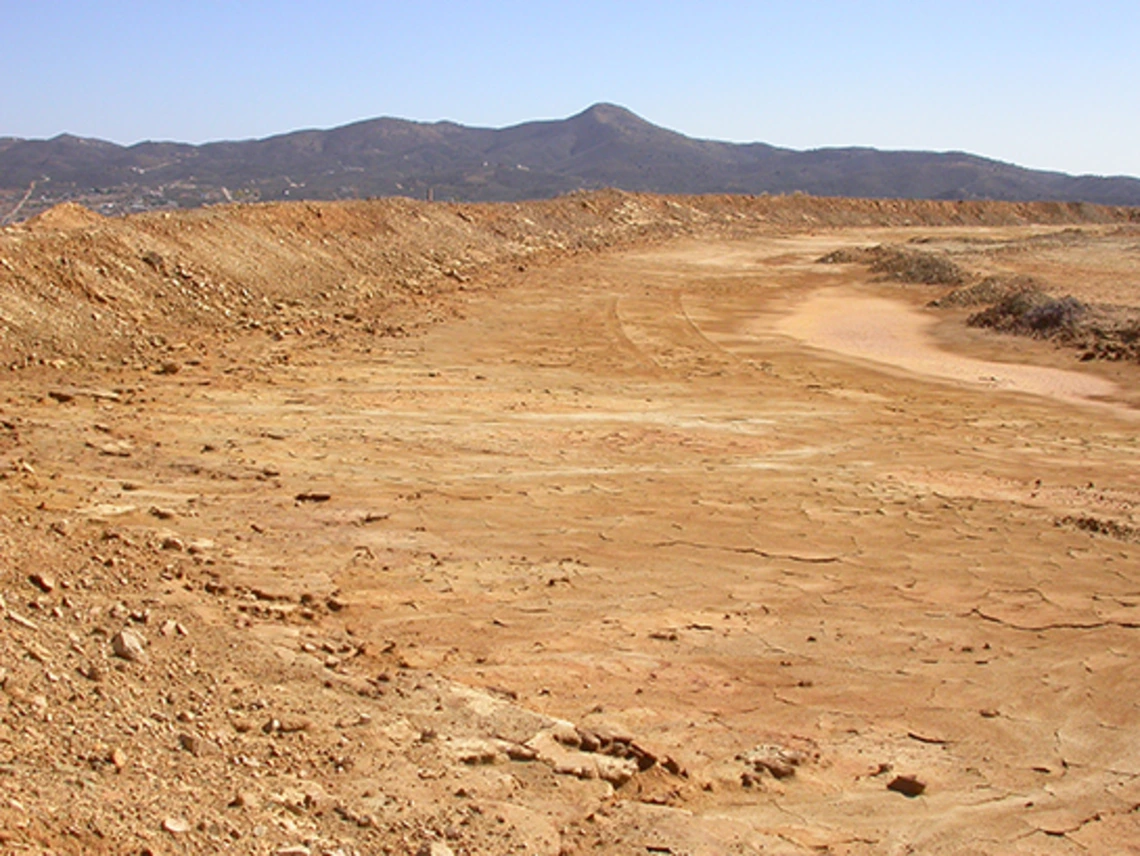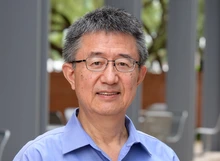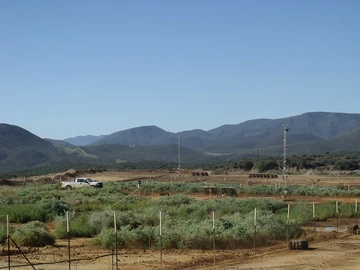U of A Superfund Research Center secures $14.8M NIEHS grant to combat hazardous dust effects in Southwest

Toxic mine tailings remain exposed across the soil at the Iron King Mine preliminary field trial site in Dewey-Humboldt, a town in Yavapai County. Loose dust spreads contamination through wind erosion into surrounding communities.
Photo courtesy of Raina Maier
The University of Arizona Superfund Research Center received a $14.8 million, five-year grant from the National Institute of Environmental Health Sciences, a division of the National Institutes of Health, to help understand and mitigate health threats from metalloid-contaminated dust from mine tailings and associated hazardous fungal spores, specifically within mining communities.
The Superfund Research Center, also known as the "The DUST Center: Hazardous Dust in Drylands- Exposure, Health Impacts, and Mitigation," was established in 1989 and has been continuously funded by the NIH since 1997. Its work focuses on mining towns and Native Nations across the Arizona-Sonora border region, where residents face chronic inhalation of arsenic-rich dust from mine tailings – waste left over from mining operations.

Raina Maier
"We are one of the very few programs in the United States that have been continually funded for more than three decades," said Raina Maier, professor at the College of Agriculture, Life and Environmental Sciences. "Securing a competing continuation award of this scale is highly uncommon and underscores the center's exceptional record of scientific and community impact."
Following a tradition of rotating leadership, Maier, who was director of the Superfund Research Center between 2012 and 2022, is now the associate director. Xinxin Ding, R. Ken Coit professor and head of the Coit College of Pharmacy Department of Pharmacology and Toxicology, is director and lead principal investigator on the new grant.
This new round of funding will support four new integrated research projects, two led by the Coit College of Pharmacy and two led by the College of Agriculture, Life and Environmental Sciences.
The first project, led by Yin Chen, professor of pharmacology and toxicology and BIO5 Institute member, will explore how arsenic and other metalloids affect lung cells and increase vulnerability to mold exposure. The project, "Effects of Arsenic and Arsenic-containing Mine Tailings Dusts on Airway Epithelium and Susceptibility to Mold Exposure," aims to uncover the previously unexplored health implications of metalloid exposure and pinpoint molecular targets for creating risk assessments, equipping communities with essential knowledge about the health hazards they might face.
The second project is building a mechanistic model of how chronic inhalation of metalloid and fungus-laden dust particles can cause fibrotic lung disease. Researchers led by Ding will detail the cellular and molecular pathways by which inhaled arsenic and airborne fungal spores damage airway tissue, impair immune defenses and drive chronic and non-malignant lung disease.

Xinxin Ding
"We have some early indications that arsenic exposure may affect the infectivity levels of fungal spores," Ding said. "We also have interesting data showing that inhalation exposure to the dust actually generates more of the most toxic kind of arsenic in the lungs than arsenic exposure in drinking water."
This double-exposure scenario more closely resembles what people are being exposed to in real life, Ding said.
The third project, "Transformation of Metal(loid)-bearing Particulate Matter and Associated Impacts on Bioaccessibility," will investigate how the size and the physical and chemical properties of mine-tailing dust particles influence the release of toxic metals into lung fluids. Jon Chorover, professor and head of the Department of Environmental Science in the College of Agriculture, Life and Environmental Sciences, will lead a team that is examining particulates across a wide range of mine sites and mining-affected residential soils, including some that have experienced wildfires, to better understand human health risks posed by these particulates.

Researchers examine whether roots of native plants will hold toxic mine tailings in place at the Iron King Mine Superfund Site preliminary field trial after planting in Dewey-Humboldt, a town in Yavapai County.
Photo courtesy of Raina Maier
Maier is leading the fourth project, "Phytoremediation of Metal-Contaminated Mine Sites in Drylands," which builds upon previous research to revegetate acidic mine tailings using carefully selected native plants and compost applications. Revegetation stabilizes soils and prevents the generation of dust containing toxic particles.
According to Maier, earlier research showed that four-wing saltbush and native buffalo grass proved best at growing in acidic metal-rich mine tailings. Initial field trials showed how strategic revegetation can stabilize the mine tailings and reduce dust erosion that spreads toxic metals into neighboring communities.
"The Southwest is hot and dry, so we generate a lot of dust that gets carried by the wind," Maier said. "These conditions also make it challenging to establish plants. We are working to determine the minimum inputs and best seasonal timing to effectively establish plants on a site. Mining companies spend a lot of money revegetating their sites and informed research like this helps them reduce these costs."
The new phase of this project will include native plant surveys to identify plant growth strategies that optimize phytoremediation performance in arid systems. The research team will also work to develop drone-based technologies to rapidly assess plant species composition and performance under metal stress over large areas using a combination of LiDAR and hyperspectral analysis.
The four projects reflect the Superfund Research Center's multidisciplinary approach of pairing biomedical and environmental science to break the chain of exposure before disease can take hold within impacted Arizona communities.
"The Superfund Research Center is a shining example of how the University of Arizona is helping Arizona communities become healthier and more resilient through our land-grant mission," said Tomás Díaz de la Rubia, senior vice president of research and partnerships. "Its work aligns perfectly with our strategic goal of advancing university research to meet the global demands for critical minerals while prioritizing safety, efficiency and sustainability."
The Superfund Research Center has repeatedly demonstrated how research endeavors translate into tangible and convergent public health protections. The long-running program has become a nation-wide model for combatting the complex health and environmental risks posed by hazardous dust in arid mining regions in the Southwest.





